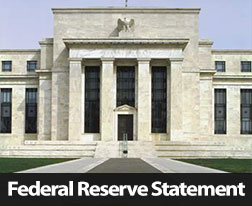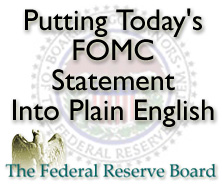 According to statement issued at the conclusion of today’s Federal Open Market Committee meeting, committee members decided against raising the target federal funds rate. Mixed economic conditions, slower economic growth in the 4th quarter and low inflation contributed to the decision against raising rates. The target federal funds rate was raised in December to a range of 0.25 to 1.59 percent after remaining at 0.00 to 0.25 percent for several years. While rising fed rates were expected to cause a hike in mortgage rates, mortgage rates fell after December’s rate hike.
According to statement issued at the conclusion of today’s Federal Open Market Committee meeting, committee members decided against raising the target federal funds rate. Mixed economic conditions, slower economic growth in the 4th quarter and low inflation contributed to the decision against raising rates. The target federal funds rate was raised in December to a range of 0.25 to 1.59 percent after remaining at 0.00 to 0.25 percent for several years. While rising fed rates were expected to cause a hike in mortgage rates, mortgage rates fell after December’s rate hike.
Committee Cites Mixed Data in Decision
While labor conditions and housing markets continue to improve, FOMC members said that further improvement in labor markets and achieving the medium term goal of inflation influenced the committee’s decision not to raise rates. The Federal Reserve has a dual goal of achieving maximum employment and 2 percent inflation. While labor conditions continue to improve, the Committee wants to see further improvement. The inflation rate has stubbornly stayed below 2 percent and lower energy and non-energy import prices caused the inflation rate to fall further in recent weeks. The Fed also downgraded its reading of household spending and business investment growth from “strong” to “moderate.”
FOMC members consider global economic and financial conditions as well as trends and developing news affecting domestic economic and financial developments. Wednesday’s statement emphasized that constant monitoring and analysis of financial and economic readings are significant in monetary policy decisions. Analysts noted that recent economic developments including slowing economic growth in the US and China, along with resulting turbulence in financial markets likely contributed to the Fed’s decision not to raise the federal funds rate.
FOMC Says Policy Decisions to Remain “Accommodative”
Members of the FOMC do not expect marked economic improvement in the short term and said that they expect Fed monetary policy to remain accommodative “for some time.” This suggests that rapid rate hikes are not likely to occur in the near future; the Fed’s commitment to gradual rate increases is expected promote further improvements in labor markets and hold down borrowing rates for consumer credit and mortgages.
The Committee’s vote not to increase rates was unanimous. The next FOMC meeting is set for March 15 and 16. In the meantime, Fed Chair and FOMC Chair Janet Yellen is slated to testify before Congress about the economic outlook on February 10 and 11.

 Last week’s scheduled economic reports included the NAHB Housing Market Index, Housing Starts, FOMC statement and Fed Chair Janet Yellen’s press conference. In addition to weekly reports on jobless claims and mortgage rates, inflation reports were also released.
Last week’s scheduled economic reports included the NAHB Housing Market Index, Housing Starts, FOMC statement and Fed Chair Janet Yellen’s press conference. In addition to weekly reports on jobless claims and mortgage rates, inflation reports were also released. Last week’s economic reports included Consumer Price Index and Core index for September, the minutes of the FOMC meeting held September 15 and 17, and weekly reports on mortgage rates and new jobless claims. The details:
Last week’s economic reports included Consumer Price Index and Core index for September, the minutes of the FOMC meeting held September 15 and 17, and weekly reports on mortgage rates and new jobless claims. The details: Last week’s economic releases included several reports related to housing. The Wells Fargo/ NAHB Housing Market Index achieved its highest reading in nearly 10 years. Housing Starts dipped in August and Building Permits issued in August exceeded July expectations. The week’s big news was actually no news. The Fed’s Federal Open Market Committee decided not to raise interest rates. Fed Chair Janet Yellen followed up on the FOMC statement with a press conference and said that the Fed is not yet ready to raise rates, but that a majority of FOMC members are prepared to raise rates before year-end.
Last week’s economic releases included several reports related to housing. The Wells Fargo/ NAHB Housing Market Index achieved its highest reading in nearly 10 years. Housing Starts dipped in August and Building Permits issued in August exceeded July expectations. The week’s big news was actually no news. The Fed’s Federal Open Market Committee decided not to raise interest rates. Fed Chair Janet Yellen followed up on the FOMC statement with a press conference and said that the Fed is not yet ready to raise rates, but that a majority of FOMC members are prepared to raise rates before year-end. The minutes for the most recent meeting of the Federal Reserve’s Federal Open Market Committee (FOMC) suggest that while committee members won’t specify a date, a rate hike could come sooner than later. Committee members continue to cite concerns over labor markets and other economic factors, but the minutes of the FOMC meeting held July 28 and 29 indicate that a majority of members see a rate change as likely in the near term.
The minutes for the most recent meeting of the Federal Reserve’s Federal Open Market Committee (FOMC) suggest that while committee members won’t specify a date, a rate hike could come sooner than later. Committee members continue to cite concerns over labor markets and other economic factors, but the minutes of the FOMC meeting held July 28 and 29 indicate that a majority of members see a rate change as likely in the near term.